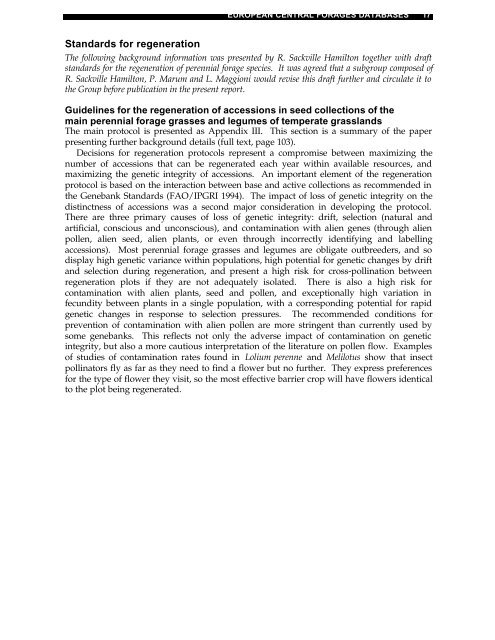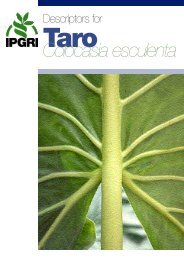Download PDF (6215 kb) - Bioversity International
Download PDF (6215 kb) - Bioversity International
Download PDF (6215 kb) - Bioversity International
Create successful ePaper yourself
Turn your PDF publications into a flip-book with our unique Google optimized e-Paper software.
EUROPEAN CENTRAL FORAGES DATABASES 17<br />
Standards for regeneration<br />
The following background information was presented by R. Sackville Hamilton together with draft<br />
standards for the regeneration of perennial forage species. It was agreed that a subgroup composed of<br />
R. Sackville Hamilton, P. Marum and L. Maggioni would revise this draft further and circulate it to<br />
the Group before publication in the present report.<br />
Guidelines for the regeneration of accessions in seed collections of the<br />
main perennial forage grasses and legumes of temperate grasslands<br />
The main protocol is presented as Appendix III. This section is a summary of the paper<br />
presenting further background details (full text, page 103).<br />
Decisions for regeneration protocols represent a compromise between maximizing the<br />
number of accessions that can be regenerated each year within available resources, and<br />
maximizing the genetic integrity of accessions. An important element of the regeneration<br />
protocol is based on the interaction between base and active collections as recommended in<br />
the Genebank Standards (FAO/IPGRI 1994). The impact of loss of genetic integrity on the<br />
distinctness of accessions was a second major consideration in developing the protocol.<br />
There are three primary causes of loss of genetic integrity: drift, selection (natural and<br />
artificial, conscious and unconscious), and contamination with alien genes (through alien<br />
pollen, alien seed, alien plants, or even through incorrectly identifying and labelling<br />
accessions). Most perennial forage grasses and legumes are obligate outbreeders, and so<br />
display high genetic variance within populations, high potential for genetic changes by drift<br />
and selection during regeneration, and present a high risk for cross-pollination between<br />
regeneration plots if they are not adequately isolated. There is also a high risk for<br />
contamination with alien plants, seed and pollen, and exceptionally high variation in<br />
fecundity between plants in a single population, with a corresponding potential for rapid<br />
genetic changes in response to selection pressures. The recommended conditions for<br />
prevention of contamination with alien pollen are more stringent than currently used by<br />
some genebanks. This reflects not only the adverse impact of contamination on genetic<br />
integrity, but also a more cautious interpretation of the literature on pollen flow. Examples<br />
of studies of contamination rates found in Lolium perenne and Melilotus show that insect<br />
pollinators fly as far as they need to find a flower but no further. They express preferences<br />
for the type of flower they visit, so the most effective barrier crop will have flowers identical<br />
to the plot being regenerated.




